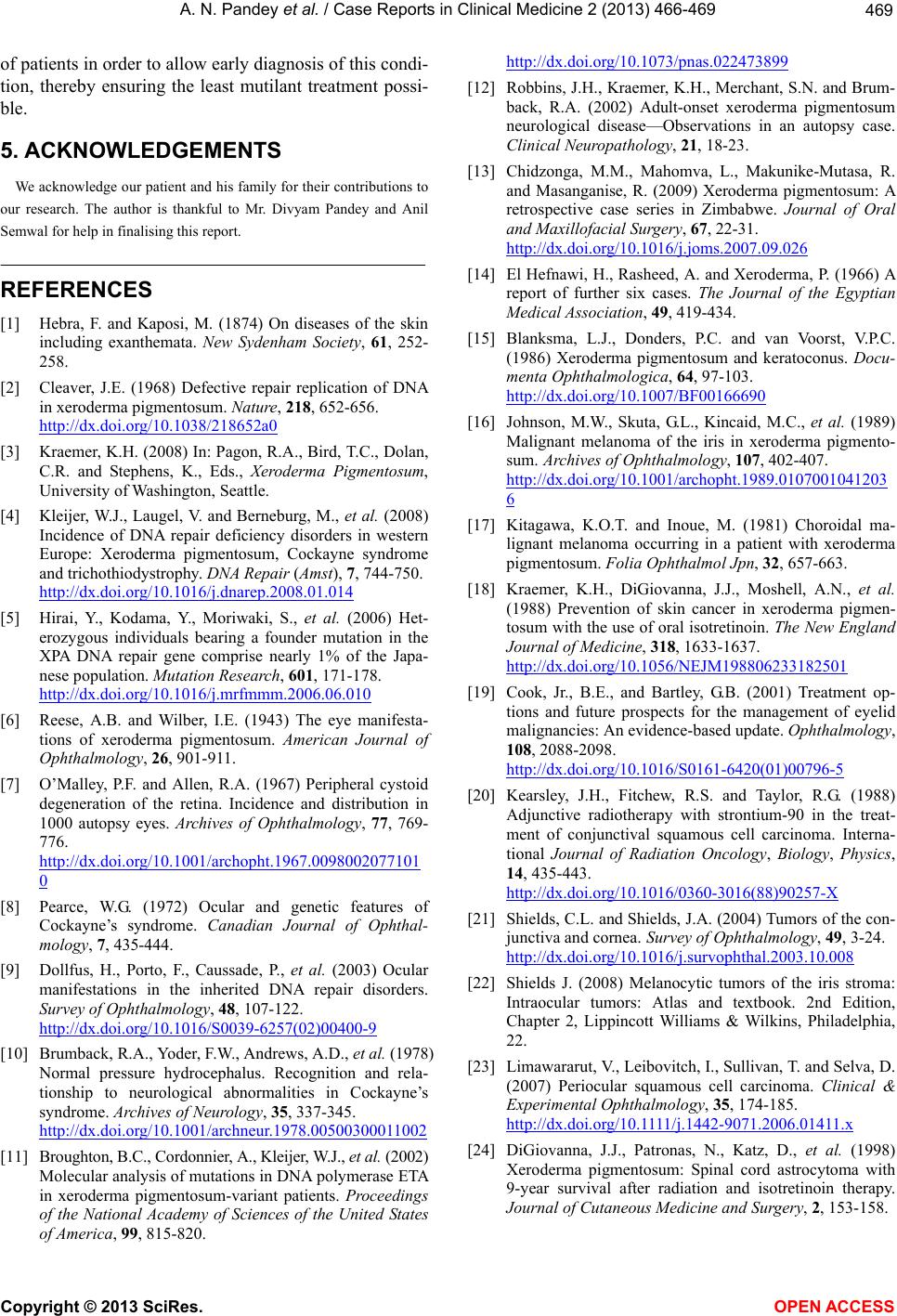
A. N. Pandey et al. / Case Reports in Clinical Medicine 2 (2013) 466-469
Copyright © 2013 SciRes.
469
of patients in order to allow early diagnosis of this cond i-
tion, thereby ensuring the least mutilant treatment possi-
ble.
OPEN A CCESS
5. ACKNOWLEDGEMENTS
We acknowledge our patient and his family for their contributions to
our research. The author is thankful to Mr. Divyam Pandey and Anil
Semwal for help in finalising this report.
REFERENCES
[1] Hebra, F. and Kaposi, M. (1874) On diseases of the skin
including exanthemata. New Sydenham Society, 61, 252-
258.
[2] Cleaver, J.E. (1968) Defective repair replication of DNA
in xeroderma pigmentosum. Nature, 218, 652-656.
http://dx.doi.org/10.1038/218652a0
[3] Kraemer, K.H. (2008) In: Pagon, R.A., Bird, T.C., Dolan,
C.R. and Stephens, K., Eds., Xeroderma Pigmentosum,
University of Washington, Seattle.
[4] Kleijer, W.J., Laugel, V. and Berneburg, M., et al. (2008)
Incidence of DNA repair deficiency disorders in western
Europe: Xeroderma pigmentosum, Cockayne syndrome
and trichothiodystrophy. DNA Repair (Amst), 7, 744-750.
http://dx.doi.org/10.1016/j.dnarep.2008.01.014
[5] Hirai, Y., Kodama, Y., Moriwaki, S., et al. (2006) Het-
erozygous individuals bearing a founder mutation in the
XPA DNA repair gene comprise nearly 1% of the Japa-
nese population. Mutation Research, 601, 171-178.
http://dx.doi.org/10.1016/j.mrfmmm.2006.06.010
[6] Reese, A.B. and Wilber, I.E. (1943) The eye manifesta-
tions of xeroderma pigmentosum. American Journal of
Ophthalmology, 26, 901-911.
[7] O’Malley, P.F. and Allen, R.A. (1967) Peripheral cystoid
degeneration of the retina. Incidence and distribution in
1000 autopsy eyes. Archives of Ophthalmology, 77, 769-
776.
http://dx.doi.org/10.1001/archopht.1967.0098002077101
0
[8] Pearce, W.G. (1972) Ocular and genetic features of
Cockayne’s syndrome. Canadian Journal of Ophthal-
mology, 7, 435-444.
[9] Dollfus, H., Porto, F., Caussade, P., et al. (2003) Ocular
manifestations in the inherited DNA repair disorders.
Survey of Ophthalmology, 48, 107-122.
http://dx.doi.org/10.1016/S0039-6257(02)00400-9
[10] Brumback, R.A., Yoder, F.W., Andrews, A.D., et al. (1978)
Normal pressure hydrocephalus. Recognition and rela-
tionship to neurological abnormalities in Cockayne’s
syndrome. Archives of Neurology, 35, 337-345.
http://dx.doi.org/10.1001/archneur.1978.00500300011002
[11] Broughton, B.C., Cordonnier , A ., Kleijer, W.J., et al. (2002)
Molecular analysis of mutations in DNA polymerase ETA
in xeroderma pigmentosum-variant patients. Proceedings
of the National Academy of Sciences of the United States
of America, 99, 815-820.
http://dx.doi.org/10.1073/pnas.022473899
[12] Robbins, J.H., Kraemer, K.H., Merchant, S.N. and Brum-
back, R.A. (2002) Adult-onset xeroderma pigmentosum
neurological disease—Observations in an autopsy case.
Clinical Neuropathology, 21, 18-23.
[13] Chidzonga, M.M., Mahomva, L., Makunike-Mutasa, R.
and Masanganise, R. (2009) Xeroderma pigmentosum: A
retrospective case series in Zimbabwe. Journal of Oral
and Maxillofacial Surgery, 67, 22-31.
http://dx.doi.org/10.1016/j.joms.2007.09.026
[14] El Hefnawi, H., Rasheed, A. and Xeroderma, P. (1966) A
report of further six cases. The Journal of the Egyptian
Medical Association, 49, 419-434.
[15] Blanksma, L.J., Donders, P.C. and van Voorst, V.P.C.
(1986) Xeroderma pigmentosum and keratoconus. Docu-
menta Ophthalmologica, 64, 97-103.
http://dx.doi.org/10.1007/BF00166690
[16] Johnson, M.W., Skuta, G.L., Kincaid, M.C., et al. (1989)
Malignant melanoma of the iris in xeroderma pigmento-
sum. Archives of Ophthalmology, 107, 402-407.
http://dx.doi.org/10.1001/archopht.1989.0107001041203
6
[17] Kitagawa, K.O.T. and Inoue, M. (1981) Choroidal ma-
lignant melanoma occurring in a patient with xeroderma
pigmentosum. Folia Ophthalmol Jpn, 32, 657-663.
[18] Kraemer, K.H., DiGiovanna, J.J., Moshell, A.N., et al.
(1988) Prevention of skin cancer in xeroderma pigmen-
tosum with the use of oral isotretinoin. The New England
Journal of Medicine, 318, 1633-1637.
http://dx.doi.org/10.1056/NEJM198806233182501
[19] Cook, Jr., B.E., and Bartley, G.B. (2001) Treatment op-
tions and future prospects for the management of eyelid
malignancies: An evidence-based update. Ophthalmology,
108, 2088-2098.
http://dx.doi.org/10.1016/S0161-6420(01)00796-5
[20] Kearsley, J.H., Fitchew, R.S. and Taylor, R.G. (1988)
Adjunctive radiotherapy with strontium-90 in the treat-
ment of conjunctival squamous cell carcinoma. Interna-
tional Journal of Radiation Oncology, Biology, Physics,
14, 435-443.
http://dx.doi.org/10.1016/0360-3016(88)90257-X
[21] Shields, C.L. and Shields, J.A. (2004) Tumors of the con-
junctiva and cor n ea. Survey of Ophthalmology, 49, 3-24.
http://dx.doi.org/10.1016/j.survophthal.2003.10.008
[22] Shields J. (2008) Melanocytic tumors of the iris stroma:
Intraocular tumors: Atlas and textbook. 2nd Edition,
Chapter 2, Lippincott Williams & Wilkins, Philadelphia,
22.
[23] Limawararut, V., Leibovitch, I., Sullivan, T. and Selva, D.
(2007) Periocular squamous cell carcinoma. Clinical &
Experimental Ophthalmology, 35, 174-185.
h ttp: //dx .do i .org/1 0 .1111/ j.1442-9071.2006.01411.x
[24] DiGiovanna, J.J., Patronas, N., Katz, D., et al. (1998)
Xeroderma pigmentosum: Spinal cord astrocytoma with
9-year survival after radiation and isotretinoin therapy.
Journal of Cutaneous Medicine and Surgery, 2, 153-158.